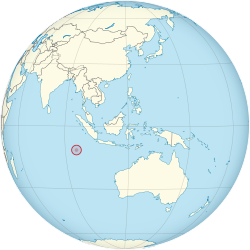Cocos Keeling Islands
|
Territory of the Cocos (Keeling) Islands
Wilayah Pulau Cocos (Keeling) (Malay)
|
|
|---|---|

|
|
 |
|
| Status | External Territory |
| Capital |
West Island 12°11′13″S 96°49′42″E / 12.18694°S 96.82833°E |
| Largest village | Bantam (Home Island) |
| Official languages | None |
| Mother languages | Malay, English |
| Demonym |
|
| Sovereign state | Australia |
| Government | Federal constitutional monarchy |
|
• Monarch
|
Elizabeth II |
|
Sir Peter Cosgrove |
|
| Barry Haase | |
| Aindil Minkom | |
| Territory of Australia | |
|
• Annexed by the
British Empire |
1857 |
|
• Transferred to
Australian control |
1955 |
| Area | |
|
• Total
|
14 km2 (5.4 sq mi) |
|
• Water (%)
|
0 |
| Population | |
|
• July 2014 estimate
|
596 (237) |
|
• Density
|
43/km2 (111.4/sq mi) (n/a) |
| Currency | Australian dollar (AUD) |
| Time zone | CCT (UTC+06:30) |
| Calling code | 61 891 |
| ISO 3166 code | CC |
| Internet TLD | .cc |
The Territory of the Cocos (Keeling) Islands, also called Cocos Islands (/ˈkoʊkəs/) and Keeling Islands, is a territory of Australia, located in the Indian Ocean, southwest of Christmas Island and approximately midway between Australia and Sri Lanka.
The territory consists of two atolls and 27 coral islands, of which two, West Island and Home Island, are inhabited with a total population of approximately 600.
The islands have been called the Cocos Islands (from 1622), the Keeling Islands (from 1703), the Cocos–Keeling Islands (since James Horsburgh in 1805) and the Keeling–Cocos Islands (19th century).Cocos refers to the abundant coconut trees, while Keeling is William Keeling, reputedly the first European to sight the islands, in 1609. John Clunies-Ross, who sailed there in the Borneo in 1825, called the group the Borneo Coral Isles, restricting Keeling to North Keeling, and calling South Keeling "the Cocos properly so called". The form Cocos (Keeling) Islands, attested from 1916, was made official by the Cocos (Keeling) Islands Act 1955.
The Cocos (Keeling) Islands consist of two flat, low-lying coral atolls with an area of 14.2 square kilometres (5.5 sq mi), 26 kilometres (16 mi) of coastline, a highest elevation of 5 metres (16 ft) and thickly covered with coconut palms and other vegetation. The climate is pleasant, moderated by the southeast trade winds for about nine months of the year and with moderate rainfall. Tropical cyclones may occur in the early months of the year.
...
Wikipedia
